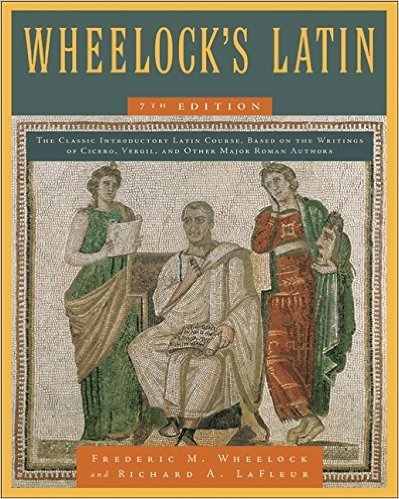Wheelock's Latin (7th edition), by Wheelock & LaFleur (A Review)

I studied Latin formally for two semesters during my Masters program using the famous textbook Wheelock's Latin. This textbook is the standard throughout universities in the US. But, I had studied Latin before on my own using various other methods. What follows is a summary of my thoughts on Wheelock and Latin pedagogy in general.
If Wheelock's Latin were a basketball player, it'd be great at making foul shots, but utterly unable to dribble.
The good: Wheelock does a good job of teaching you Latin grammar.
The bad: it does a good job teaching you Latin grammar--and nothing else. This book teaches you to "read" Latin sentences like algebraic equations--break a contextless sentence into its component parts and solve for the subject, verb, etc. This approach goes against everything we know about how the brain acquires language.
When it does offer reading passages with some context, many are epigrams or poetry which feature tricky syntax. Not until you've completed the entire 40 chapters of grammar do you encounter more than one paragraph of contiguous, simple Latin prose. Each chapter ends with a rambling page or two about some ancient Latin graffiti--pages and pages wasted on what amounts to a few sentences that could have been dedicated to useful, graded reading passages. It also tries to insert as much unadapted Latin as possible, as early as possible. Because, you know, new Latin students should cut their teeth on Cicero just as ESL students do with Shakespeare...
Considering that the main thing one can do with Latin is read in it, any course intended for beginners should be focused on developing reading proficiency, but this is not the aim of this book. Wheelock teaches you to translate Latin into English with the aid of a dictionary. If that's all you want, Wheelock is for you. If your goal is to have read at least one simple book--or even a short story--in Latin after a year of study, then this is not the book for you.
It's not that this book is horrible, it is not. However, I think the approach is all wrong for "a book which provides both the roots and at least some literary fruits of a sound Latin experience for those who will have only a year or so of Latin in their entire educational career" (Preface). With this goal in mind, labeling the various uses of the ablative or subjunctive clause types would not be high on my list of importance. Ernest Blum outlines the why and how of a program that would address the scenario Wheelock intended to with his book.
Instead, I'd recommend Orberg's Lingua Latina. It is written entirely in Latin (including grammar instruction) so you are reading from day 1 and naturally develop a feel for Latin word order, etc. It sounds like an all Latin text would be hard to use, but the author is very clever in how he puts everything together. The lessons form a continuous, and often humorous, narrative which is fun to read and re-read.
I've completed both courses and Lingua Latina is better by far. That said, Wheelock would be a good grammar review after completing Orberg.
The Reading Latin course by Cambridge University Press also looks very good but I haven't done it (yet) so I can't recommend it. I'd describe it as a middle ground between the Orberg and Wheelock methods.
This post has been ranked within the top 80 most undervalued posts in the second half of Mar 25. We estimate that this post is undervalued by $3.81 as compared to a scenario in which every voter had an equal say.
See the full rankings and details in The Daily Tribune: Mar 25 - Part II. You can also read about some of our methodology, data analysis and technical details in our initial post.
If you are the author and would prefer not to receive these comments, simply reply "Stop" to this comment.